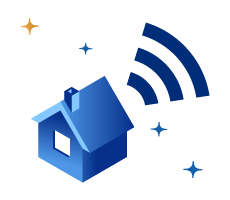Sky Muster vs Starlink: Which Satellite Internet is Better in Australia?
For remote and rural Australians, satellite internet can be the only way to stay connected. Until recently, Sky Muster was the main provider of satellite internet through the NBN Co, but with the arrival of Starlink, regional households finally have another high-speed option. So, how do Sky Muster and Starlink compare in terms of speed, price, reliability, and availability? This guide breaks down the pros and cons of each to help you decide which satellite internet service is right for your location and needs.
What Is Sky Muster?
Sky Muster is the NBN's satellite service, launched by the Australian Government to provide broadband access to homes and businesses in rural and remote areas that are not covered by fixed-line or fixed wireless NBN. There are two Sky Muster satellites in orbit—Sky Muster and Sky Muster Plus. These satellites connect users across most of the country, especially in outback areas, islands, or mountainous terrain where other forms of internet aren't viable. Sky Muster plans are sold through NBN providers like SkyMesh, Activ8me, Clear Networks, and IPSTAR.
What Is Starlink?
Starlink is a private satellite internet service developed by SpaceX, aiming to provide global broadband coverage using a low-earth orbit (LEO) satellite network. Because Starlink’s satellites orbit much closer to Earth than traditional geostationary satellites like Sky Muster, the result is much faster speeds and significantly lower latency. Starlink is available throughout most of Australia, including remote locations like the Kimberley, Tasmania, and the Red Centre. Users install a small satellite dish (“Dishy”) and connect to a router supplied by Starlink. It’s a direct-to-consumer service, meaning you order and manage your service directly through the Starlink website, not via a third-party provider.
Sky Muster vs Starlink: Key Differences
Let’s compare Sky Muster and Starlink across several important categories:
Speed & Latency
Sky Muster offers typical evening speeds of 12 Mbps to 25 Mbps, depending on your plan. Sky Muster Plus can provide higher speeds, particularly for unmetered services like browsing, email, and software updates, but it’s still limited by the nature of geostationary satellites (which sit 36,000 km above Earth). This results in latency of around 600ms or more—enough to cause noticeable lag during Zoom calls, video games, or VoIP. Starlink, on the other hand, delivers download speeds between 50 Mbps and 150 Mbps, with some users seeing even faster performance. The latency averages 20-40ms, making it comparable to fixed-line services like NBN Fibre and far more suitable for real-time tasks like gaming, video conferencing, and streaming in HD.

Cost Comparison
Sky Muster plans are relatively affordable and often include government subsidies. Basic plans start around $35 to $55/month, with data caps and peak/off-peak usage limits. Higher-tier plans can exceed $100/month, and you may need to pay extra for unmetered or "Plus" features. Starlink is more expensive upfront, with a $599 hardware cost and $139/month for the residential plan. There's also a mobile/Roam plan available for those who want satellite internet while travelling. While it costs more, Starlink is unlimited and doesn’t throttle speeds based on usage patterns—making it a more modern solution.
Hardware & Installation
Sky Muster installations are managed through your NBN provider and generally include the setup and satellite dish at no extra cost. However, scheduling an install can take time, and relocating the equipment if you move isn't always straightforward. Starlink ships the hardware directly to you, and most customers install it themselves using the supplied kit and app. The Starlink dish is motorized and self-aligning, meaning it can adjust to find the optimal satellite signal automatically.
Reliability & Weather
Sky Muster’s higher orbit means signal dropouts can occur during heavy rain, storms, or solar interference. Additionally, congestion can be an issue, especially during peak evening hours when many users are competing for limited bandwidth. Starlink's LEO satellite network performs better during bad weather and is less prone to congestion due to its growing satellite constellation. However, obstructions like trees or buildings can affect signal quality—so having a clear view of the sky is essential.
| Feature | Sky Muster | Starlink |
|---|---|---|
| Type | NBN geostationary satellite | LEO satellite (SpaceX) |
| Speed | 12–25 Mbps (up to 50 Mbps for some Sky Muster Plus plans) | 50–150 Mbps (potentially higher) |
| Latency | ~600ms | ~20–40ms |
| Data Limits | Often capped; unmetered for some traffic with Sky Muster Plus | Unlimited |
| Price | $35–$110/month | $139/month (plus $599 hardware) |
| Installation | Professional, often free | DIY, included with hardware kit |
| Best for | Budget-conscious households in deep remote areas | High-speed users needing low latency |
Which Should You Choose?
If you're in a very remote or off-grid area and need a budget-friendly option with decent speeds for basic browsing, Sky Muster remains a viable choice—especially with Sky Muster Plus plans that un-meter everyday tasks like email, online banking, and software updates. However, if you need fast, reliable internet for video calls, streaming, online learning, or gaming, Starlink is the clear winner. Despite the higher price, the performance is in a different league altogether. With lower latency and faster speeds, it feels much closer to metro-grade broadband—even when you’re hundreds of kilometers from the nearest city.
Starlink and Sky Muster Availability in Australia
Both services are available Australia-wide, but the technological reach and infrastructure differ. Sky Muster is tied to NBN Co’s satellite infrastructure and only available to households in designated satellite-serviced zones. If you’re eligible, your NBN provider will handle the application and installation.
Starlink has no eligibility requirements based on NBN service class—it simply depends on whether your location is within an active service area. Most of Australia is already covered, and new areas are being added regularly.

What About Starlink Mobile (Roaming)?
Starlink now offers a Mobile/Roam plan that works in vehicles, RVs, and caravans. This is ideal for grey nomads, truck drivers, or off-grid travelers who need connectivity across regional Australia. Sky Muster does not currently support portable installations, making Starlink a strong alternative for those constantly on the move.
Final Thoughts: Sky Muster or Starlink?
Choosing between Sky Muster and Starlink comes down to your budget, internet needs, and how remote your property is. For low-cost, government-backed internet that covers basic browsing and admin tasks, Sky Muster is still a solid option. But if you want fast, modern internet that feels like city-grade broadband—even in the middle of nowhere—Starlink offers a game-changing experience that more and more regional Australians are embracing.
Internal Links & Related Reading
- Best NBN alternatives in Australia
- Starlink Australia review
- Compare satellite internet plans
- Is fixed wireless NBN available in my area?
- Best internet for remote work in Australia
Sky Muster vs Starlink – FAQ
What is the biggest difference between Sky Muster and Starlink?
Starlink uses thousands of low-earth satellites, giving faster speeds (50–240 Mbps) and much lower latency (20–60ms) than NBN Sky Muster, which relies on two high-altitude, geostationary satellites with higher latency (600ms+).
Which is cheaper: Sky Muster or Starlink?
Sky Muster offers lower monthly costs (from $35/month) and free professional install, but has lower speed and often caps data. Starlink costs $139/month plus ~$599–$924 hardware, but includes unlimited data and is user-installed.
Is Starlink available everywhere in Australia?
Yes, Starlink is available across all of Australia as long as you have a clear view of the sky. Sky Muster requires your address be in the NBN satellite service class.
How do reliability and weather compare?
Starlink is generally more resilient to congestion but can be affected by line-of-sight blockages. Sky Muster may suffer more from rain fade and peak-hour slowdowns but is stable for basic use.
Who should choose Starlink over Sky Muster?
Choose Starlink if you require city-grade speeds and latency or often work remotely, video conference, stream, or game online in rural areas—and are willing to pay higher monthly and hardware costs.
Click below to find a better deal for your home!




